The Relationship between Effective and Equitable Water Allocation, Local Rice Farmer Participation and Economic Well-Being: Insights from Thailand’s Chiang Mai Province
Abstract
:1. Introduction
2. Materials and Methods
3. Results
3.1. Demographics of Respondents
3.2. Evaluation of Water Distribution Service to Individual Farm Units
3.3. Participation in the Irrigation Operation
3.4. Yield Performance and Agricultural Income
4. Discussion
5. Conclusions
Acknowledgments
Author Contributions
Conflicts of Interest
References
- Pradhan, P. Patterns of Irrigation Organization in Nepal. Available online: http://publications.iwmi.org/pdf/h_5910i.pdf (accessed on 15 December 2015).
- Benjamin, P.; Lam, W.F.; Ostrom, E.; Shivakoti, G. Institutions, Incentives, and Irrigation in Nepal. Available online: http://pdf.usaid.gov/pdf_docs/PNABT150.pdf (accessed on 25 January 2015).
- Vermillion, D. The Turnover and Self-Management of Irrigation Institutions in Developing Countries. Available online: http://publications.iwmi.org/pdf/H_12748.pdf (accessed on 9 October 2013).
- Ostrom, E.; Gardner, R. Coping with asymmetries in the commons: Self-governing irrigation systems can work. J. Econ. Perspect. 1993, 7, 93–112. [Google Scholar] [CrossRef]
- Shivakoti, G.; Ostrom, E. Farmer and Government Organized Irrigation Systems in Nepal: Preliminary Findings from Analysis of 127 Systems. Available online: https://dlc.dlib.indiana.edu/dlc/bitstream/handle/10535/4957/Farmer%20and%20Government%20Organized%20Irrigation%20Systems%20in%20Nepal%20Preliminary%20Findings%20From%20Analysis%20of%20127%20Systems.pdf?sequence=1&isAllowed=y (accessed on 1 April 2017).
- Lam, W.; Lee, M.; Ostrom, E. An Institutional Analysis Approach: Findings from the NIIS on Irrigation Performance. Available online: https://ideas.repec.org/p/iwt/bosers/h016269.html (accessed on 14 February 2014).
- Lam, W. Governing Irrigation Systems in Nepal: Institutions, Infrastructure, and Collective Action. Available online: https://www.cabdirect.org/cabdirect/abstract/20016785126 (accessed on 25 January 2015).
- Shivakoti, G. Participatory interventions in farmer-managed irrigation systems in Northern Thailand: Dynamism in resource mobilization. In Proceedings of the Eighth Conference of the International Association for the Study of Common Property, Bloomington, IN, USA, 31 May–4 June 2000. [Google Scholar]
- Ounvichit, T.; Satoh, M. Effects of Institutional Set-Up on Participation in Irrigation Management. Available online: https://scholar.google.co.th/scholar?hl=en&q=Khounvichit%2C+T.%3B+Satoh%2C+M.+Effects+of+institutional+set-up+on+participation+in+irrigation+management&btnG=&as_sdt=1%2C5&as_sdtp= (accessed on 1 April 2017).
- Tan-Kim-Yong, U.; Bruns, P.; Bruns, B. The Emergence of Polycentric Water Governance in Northern Thailand. Available online: http://www.bryanbruns.com/Ping-Yom9l.pdf (accessed on 5 March 2014).
- Heyd, H.; Neef, A. Public participation in water management in northern Thai highlands. Water Policy 2006, 8, 395–413. [Google Scholar] [CrossRef]
- Neef, A. Lost in translation: The participatory imperative and local water governance in North Thailand and Southwest Germany. Water Altern. 2008, 1, 89. [Google Scholar]
- Uphoff, N.; Ramamurthy, P.; Steiner, R. Managing Irrigation: Analyzing and Improving the Performance of Breaucracies. Available online: https://www.cabdirect.org/cabdirect/abstract/19921898674 (accessed on 4 February 2015).
- Ostrom, E.; Ahn, T.K. Foundations of Social Capital. Available online: http://era-mx.org/biblio/Ostrom_and_Ahn_2003.pdf (accessed on 22 February 2015).
- Marshall, G.R.; Patrick, I.W.; Muktasam, A.; Ambarawati, I.G.A.A. Alleviating Poverty by Linking Smallholders with Agribusiness: Roles of Social Capital and Common Property. In Proceedings of the 11th Biennial Conference of the International Association for the Study of Common Property, Ubud, Bali, Indonesia, 19–23 June 2006. [Google Scholar]
- Rockström, J. Rethinking Water Management: Innovative Approaches to Contemporary Issues; Routledge Press: London, UK, 2003. [Google Scholar]
- Ounvichit, T.; Wattayu, S.; Satoh, M. Participatory Management Structure of Large-Scale People’s Irrigation System: The Case of the Soprong Muang Fai System, Northern Thailand. Available online: http://repository.kulib.kyoto-u.ac.jp/dspace/bitstream/2433/66910/1/4605.pdf (accessed on 25 February 2015).
- Cullen, L.; Pretty, J.; Smith, D.; Pilgrim, S. Links between local ecological knowledge and wealth in indigenous communities of Indonesia: Implications for conservation of marine resources. Int. J. Interdiscip. Soc. Sci. 2007, 2, 289–299. [Google Scholar]
- Norton, R.D. Agricultural Development Policy: Concepts and Experiences; John Wiley & Sons Press: Chichester, UK, 2004. [Google Scholar]
- Kranz, W.; Eisenhauer, D.; Retka, M. Water and energy conservation using irrigation scheduling with center-pivot irrigation systems. Agric. Water Manag. 1992, 22, 325–334. [Google Scholar] [CrossRef]
- Food and Agriculture Organization of the United Nations (FAO). Investment in Land and Water. In Proceedings of the Regional Consultation at Bangkok, Bangkok, Thailand, 3–5 October 2001. [Google Scholar]
- Eching, S.; Frame, K.; Snyder, L. Role of Technology in Irrigation Advisory Services: The CIMIS Experience. Available online: https://scholar.google.co.th/scholar?hl=en&q=Eching%2C+S.%3B+FRAME%2C+K.%3B+SNYDER%2C+L.+Role+of+technology+in+irrigation+advisory+services%3A+The+CIMIS+experience.&btnG=&as_sdt=1%2C5&as_sdtp= (accessed on 19 April 2017).
- Ortega-Farias, S.; Acevedo, C.; Acevedo, A.; Leyton, B. Talca Irrigation Management System (TIMAS) for Grapevine; ISHS ActaHorticulturae Press: Talca, Chile, 2003; pp. 499–504. [Google Scholar]
- Gleick, P.; Christian-Smith, J.; Cooley, H. Water-use efficiency and productivity: Rethinking the basin approach. Water Int. 2011, 36, 784–798. [Google Scholar] [CrossRef]
- Cooley, H.; Christian-Smith, J.; Gleick, P.H.; Cohen, M.J.; Heberger, M. Saving Water, Energy, and Money. In California’s Next Million Acre-Feet, 2nd ed.; Ross, N., Luu, P., Eds.; Pacific Institute Press: Oakland, CA, USA, 2010. [Google Scholar]
- Gomez, K.A. Rice, the Grain of Culture. Available online: http://www.thairice.org/html/article/pdf_files/Rice_thegrain_of_Culture.pdf (accessed on 1 April 2017).
- Tanthien, B. Rice Production in Thailand. Available online: http://pdf.usaid.gov/pdf_docs/pnabe717.pdf#page=114 (accessed on 1 April 2017).
- Clemmens, A.J.; Molden, D.J. Water uses and productivity of irrigation systems. Irrig. Sci. 2007, 25, 247–261. [Google Scholar] [CrossRef]
- Burt, C.M.; Styles, S.W. Conceptualizing irrigation project modernization through benchmarking and the rapid appraisal process. Irrig. Drain. 2004, 53, 145–154. [Google Scholar] [CrossRef]
- Burt, C.; Styles, S. Rapid Appraisal Process (RAP) and Benchmarking Explanation and Tools. Available online: http://digitalcommons.calpoly.edu/cgi/viewcontent.cgi?article=1032&context=bae_fac (accessed on 5 March 2014).
- Burt, C.M.; Styles, S.W. Modern Water Control and Management Practices in Irrigation: Impact on Performance. Available online: https://pdfs.semanticscholar.org/7b87/1247a9c62c40c9f72b1457106c749251dee7.pdf (accessed on 30 March 2017).
- Nguyen, V. Tender evaluation by fuzzy sets. J. Constr. Eng. Manag. 1985, 111, 231–243. [Google Scholar] [CrossRef]
- Royal Irrigation Department (RID). Improvement Plans for Mae Kuang Operation and Maintenance Project; Ministry of Agriculture and Cooperatives Press: Bangkok, Thailand, 2012.
- El-Awad, O.; Gowing, J.; Mawdsley, J. An approach to multi-criterion evaluation of irrigation system performance. Irrig. Drain. Syst. 1991, 5, 61–75. [Google Scholar] [CrossRef]
- Sam-Amoah, L.; Gowing, J. Assessing the performance of irrigation schemes with minimum data on water deliveries1. Irrig. Drain. 2001, 50, 31–39. [Google Scholar] [CrossRef]
- Ghosh, S.; Singh, R.; Kundu, D. Evaluation of irrigation-service utility from the perspective of farmers. Water Resour. Manag. 2005, 19, 467–482. [Google Scholar] [CrossRef]
- Van der Zaag, P.; Rap, E. The pivotal role of canal operators in irrigation schemes: The case of the canalero. Irrig. Drain. 2012, 61, 436–448. [Google Scholar] [CrossRef]
- Operation and Maintenance Assessments. Available online: https://www.energystar.gov/ia/business/assessment.pdf (accessed on 22 February 2016).
- Brouwer, C.; Prins, K.; Heibloem, M. Irrigation Water Management: Irrigation Scheduling. Available online: http://s3.amazonaws.com/academia.edu.documents/33925749/Irrigation.pdf?AWSAccessKeyId=AKIAJ56TQJRTWSMTNPEA&Expires=1484821084&Signature=ozyixXntg1NriHGSRcytM%2Fpby%2BI%3D&response-content-disposition=inline%3B%20filename%3DIrrigation_Water_Management_Irrigation_S.pdf (accessed on 12 November 2015).
- Bahamish, A. Republic of Yemen Ministry of Agriculture and Irrigation. Available online: http://www.yemenwater.org/wp-content/uploads/2013/01/wp30-final-report-mis-gis.pdf (accessed on 3 January 2014).
- Ostrom, E.; Benjamin, P. Design principles and the performance of farmer managed irrigation systems in Nepal. In Performance Measurement in Farmer-Managed Irrigation Systems; Manor, S., Chambouleyron, J., Eds.; International Irrigation Management Institution: Columbo, Sri Lanka, 1993; pp. 53–62. [Google Scholar]
- Ghazouani, W.; Molle, F.; Rap, E. Water Users Associations in the NEN Region IFAD Interventions and Overall Dynamics. Available online: http://www.un.org/waterforlifedecade/water_cooperation_2013/pdf/water_users_associations_in_nen_region.pdf (accessed on 16 December 2014).
- Ahmed, A. Technology management in the Sudan: Strategic and policy challenges. Manag. Decis. 2003, 41, 267–273. [Google Scholar] [CrossRef]
- Abdelhadi, A.; Adam, H.; Hassan, M.; Hata, T. Participatory management: Would it be a turning point in the history of the Gezira scheme? Irrig. Drain. 2004, 53, 429–436. [Google Scholar] [CrossRef]
- Garces-Restrepo, C.; Vermillion, D.; Muñoz, G. Irrigation Management Transfer. Worldwide Efforts and Results. Available online: http://www.fao.org/3/a-a1520e.pdf (accessed on 12 December 2015).
- Gunchinmaa, T.; Yakubov, M. Institutions and transition: Does a better institutional environment make water users associations more effective in Central Asia? Water Policy 2010, 12, 165. [Google Scholar] [CrossRef]
- Shivakoti, G. Facilitating Policies for Improved Governance and Management of Asian Irrigation Systems. Available online: https://www.researchgate.net/profile/Ganesh_Shivakoti/publication/228763886_Facilitating_Policies_for_Improved_Governance_and_Management_of_Asian_Irrigation_Systems/links/0deec534b28ab3be22000000.pdf (accessed on 15 January 2014).
- Quadrini, V. Entrepreneurship, saving, and social mobility. Rev. Econ. 2000, 3, 1–40. [Google Scholar] [CrossRef]
- Haugh, H. A research agenda for social entrepreneurship. Soc. Enterp. J. 2005, 1, 1–12. [Google Scholar] [CrossRef]
- Bruns, B. Participatory Management for Agricultural Water Control in Vietnam: Challenges and Opportunities. Available online: http://www.bryanbruns.com/opportun.html (accessed on 19 April 2017).
- Gorantiwar, S.; Smout, I. Multilevel approach for optimizing land and water resources and irrigation deliveries for tertiary units in large irrigation schemes. II: Application. J. Irrig. Drain. Eng. 2005, 131, 264–272. [Google Scholar] [CrossRef]
- Badawy, H.A. Exchange of Irrigation Water between Farmers in Egypt. Available online: http://iwtc.info/2005_pdf/07-3.pdf (accessed on 10 December 2016).
- Shivakoti, G.; Bastakoti, R. The robustness of Montane irrigation systems of Thailand in a dynamic human-water resources interface. J. Inst. Econ. 2006, 2, 227–247. [Google Scholar] [CrossRef]
- Neef, A.; Bollen, A.; Sangkapitux, C.; Chamsai, L.; Elstner, P. Can Local Communities Manage Water Resources Sustainably? Evidence from the Northern Thai Highlands. Available online: http://www.tucson.ars.ag.gov/isco/isco13/PAPERS%20M-Q/NEEF%201.pdf (accessed on 11 December 2016).
- Levidow, L.; Zaccaria, D.; Maia, R.; Vivas, E.; Todorovic, M.; Scardigno, A. Improving water-efficient irrigation: Prospects and difficulties of innovative practices. Agric. Water Manag. 2014, 146, 84–94. [Google Scholar] [CrossRef]
- Ghazouani, W.; Marlet, S.; Mekki, I.; Vidal, A. Farmers’ perceptions and engineering approach in the modernization of a community-managed irrigation scheme. A case study from an oasis of the Nefzawa (South of Tunisia). Irrig. Drain. 2009, 58, 285–296. [Google Scholar] [CrossRef]
- Meinzen-Dick, R.; Raju, K.V.; Gulati, A. What affects organization and collective action for managing resources? Evidence from canal irrigation systems in India. World Dev. 2002, 30, 649–666. [Google Scholar] [CrossRef]
- Jovanovic, B. Selection and the Evolution of Industry. Econom. J. Econom. Soc. 1982, 50, 649–670. [Google Scholar] [CrossRef]
- Pakes, A.; Ericson, R. Empirical implications of alternative models of firm dynamics. J. Econ. Theory 1998, 79, 1–45. [Google Scholar] [CrossRef]
- Srivastava, A.; Tripathi, N.K.; Gokhale, K.V.G.K. Mapping groundwater salinity using IRS-1B LISS II data and GIS techniques. Int. J. Remote Sens. 1997, 18, 2853–2862. [Google Scholar] [CrossRef]
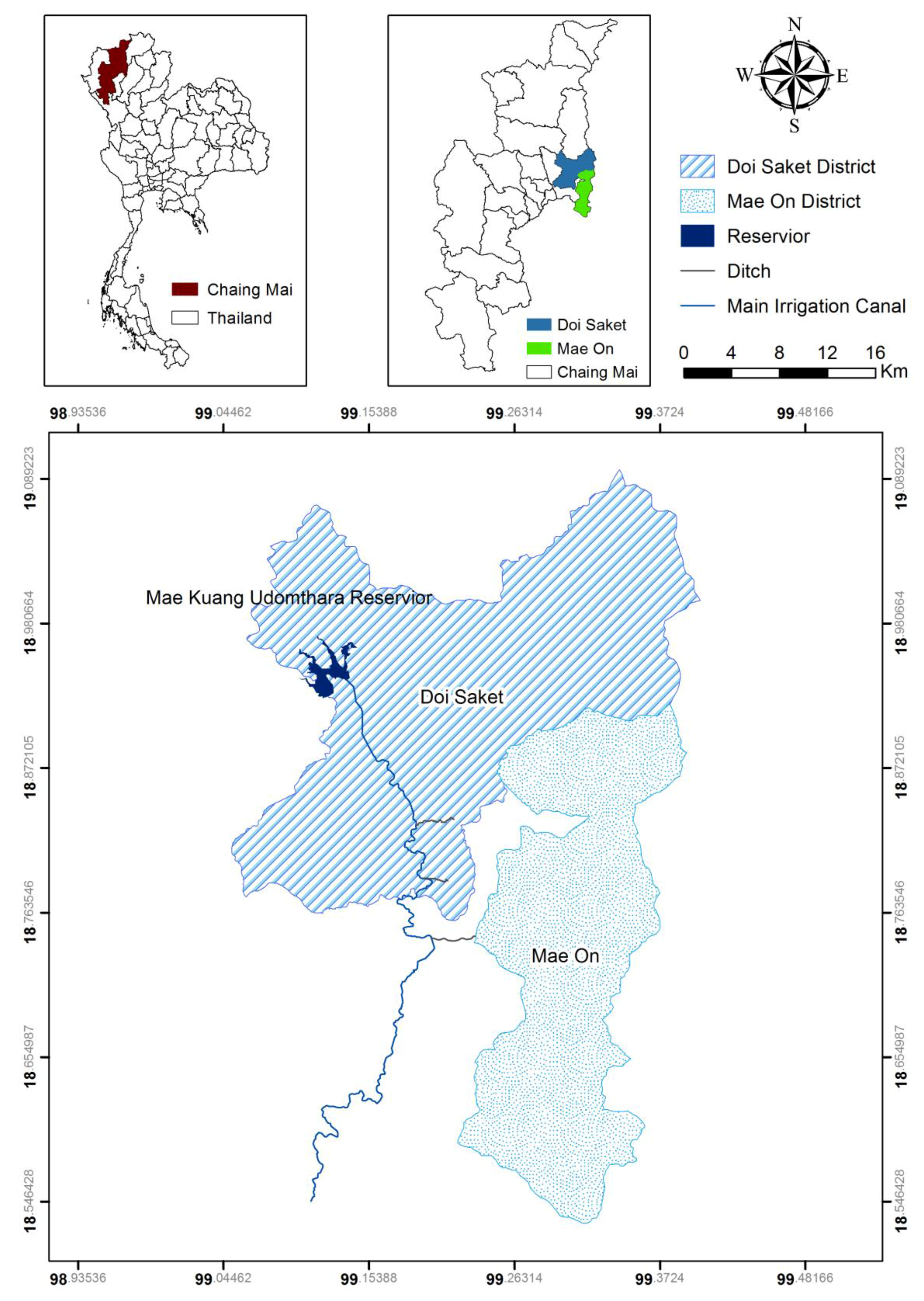
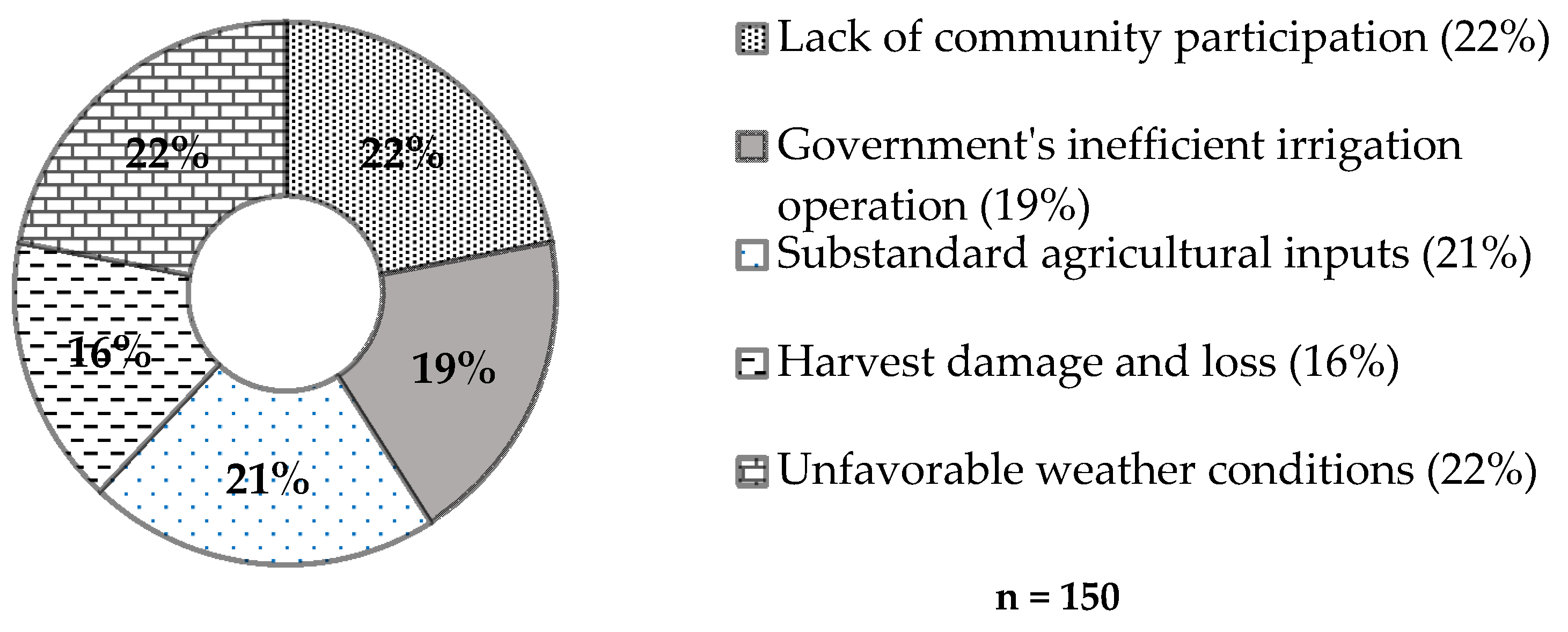
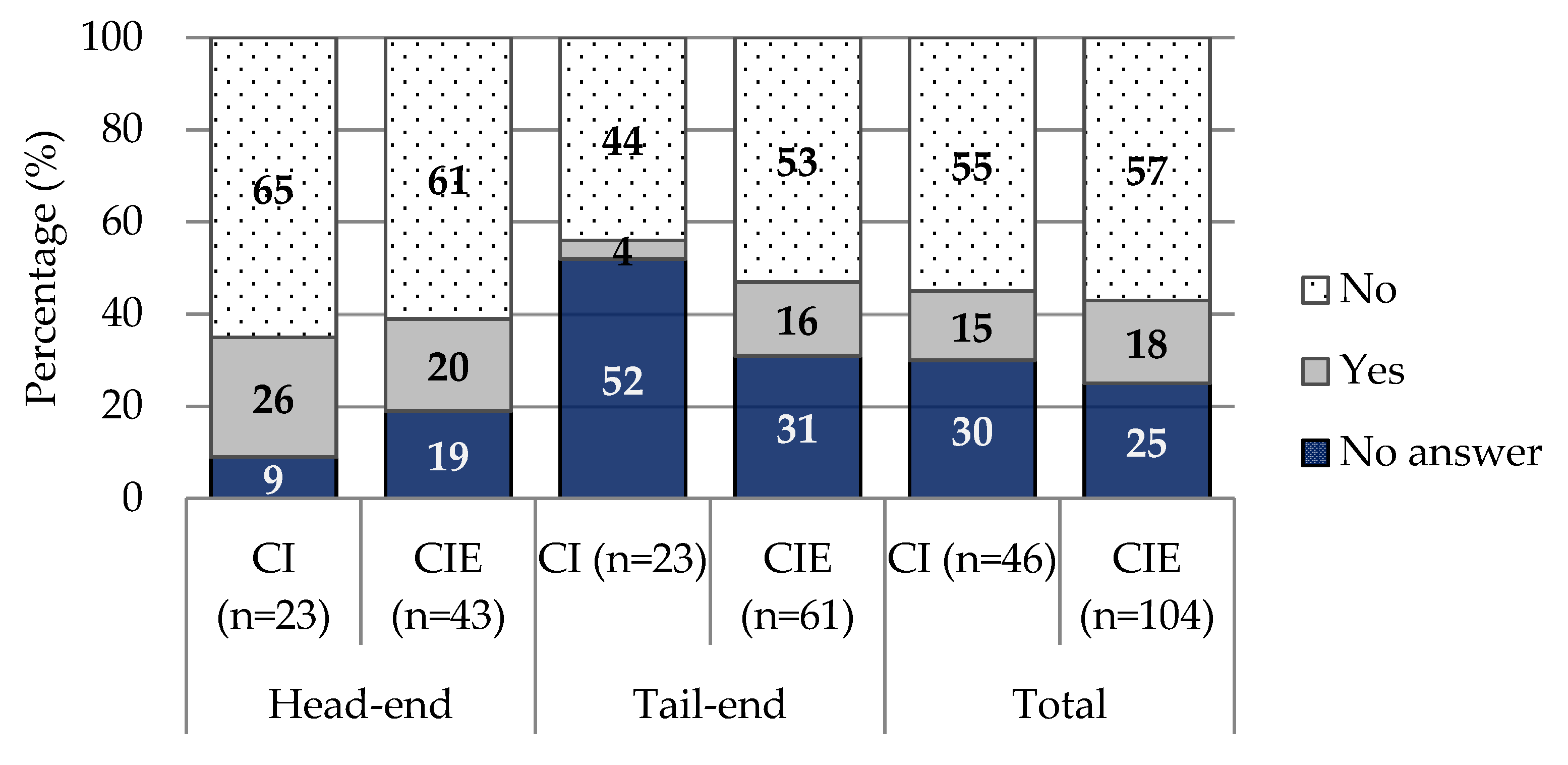

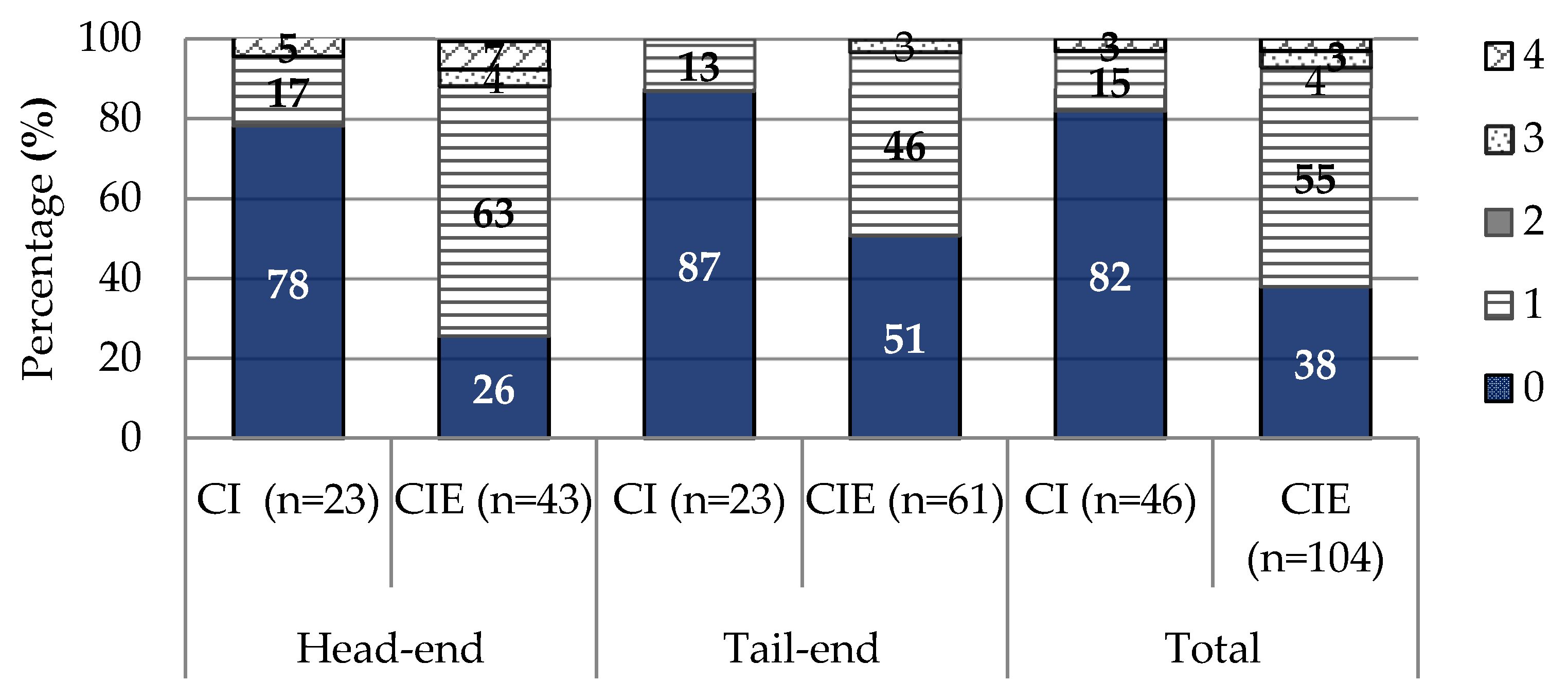
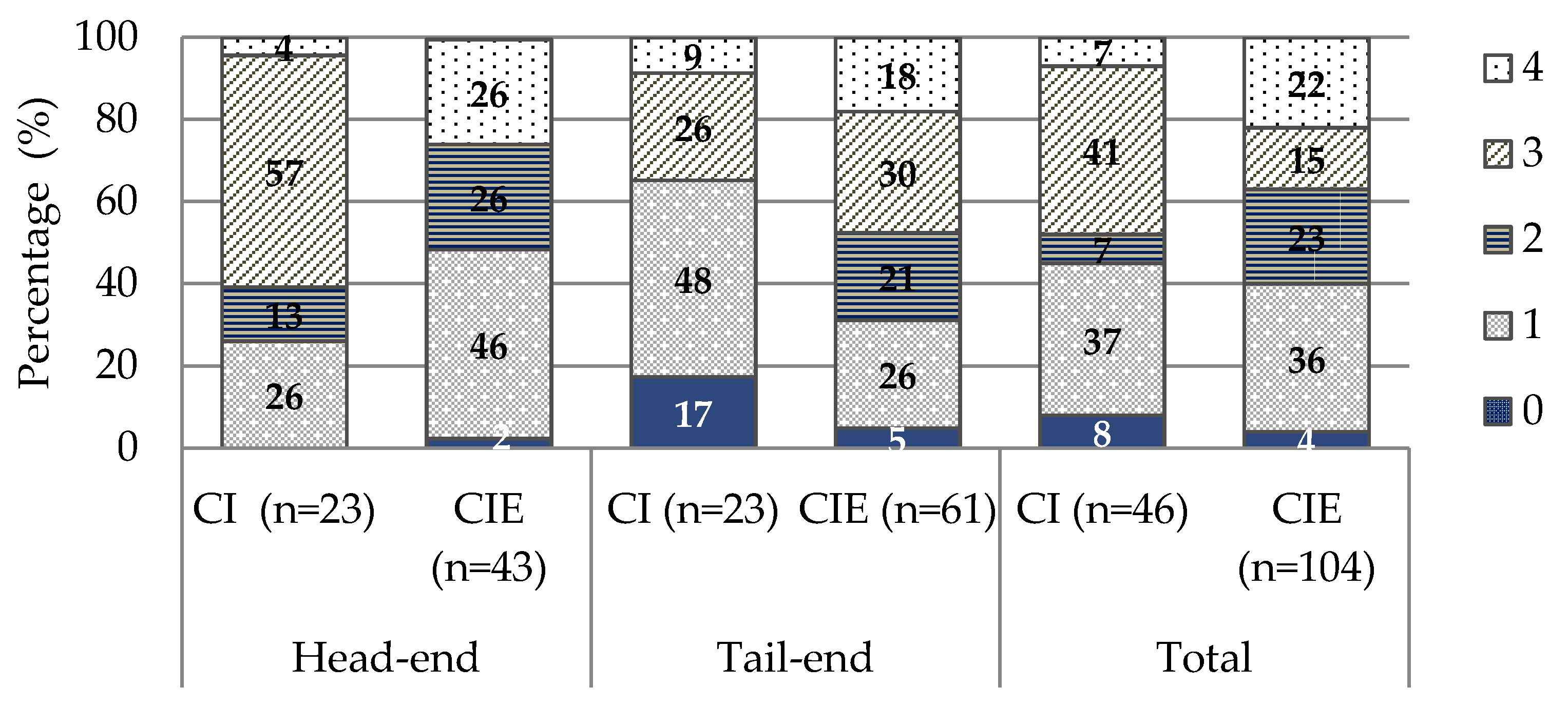
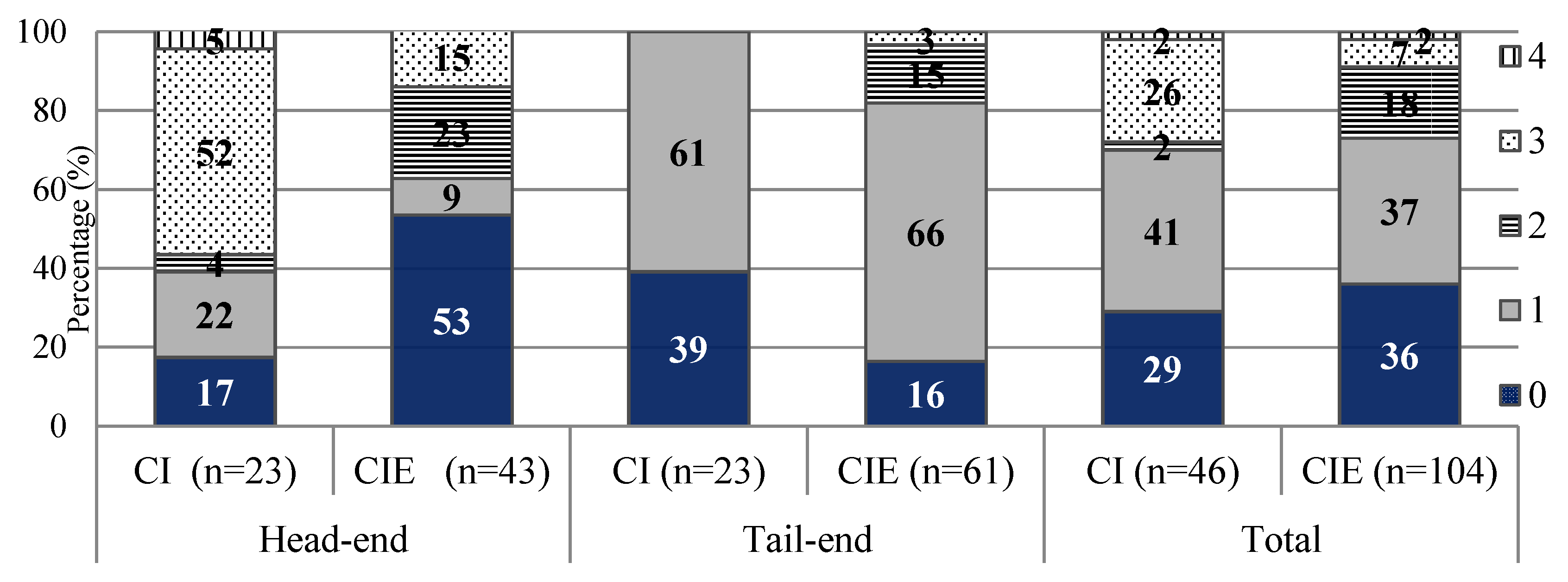


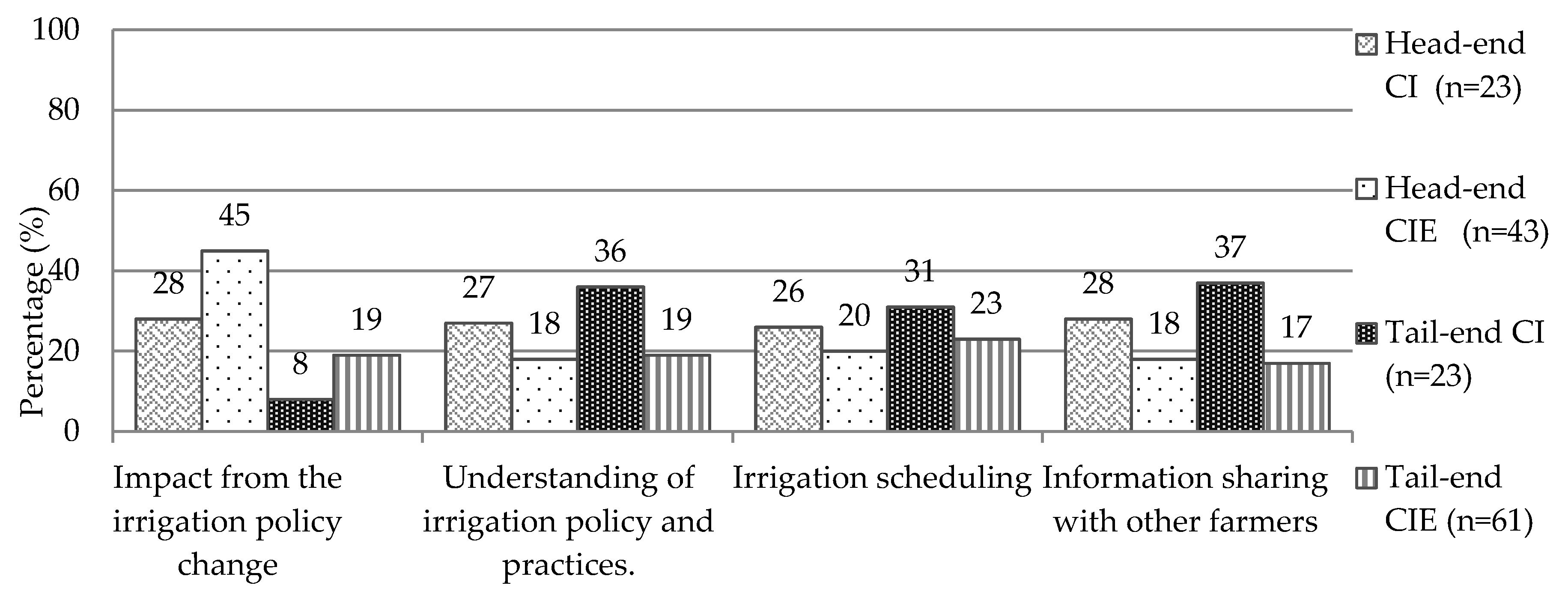
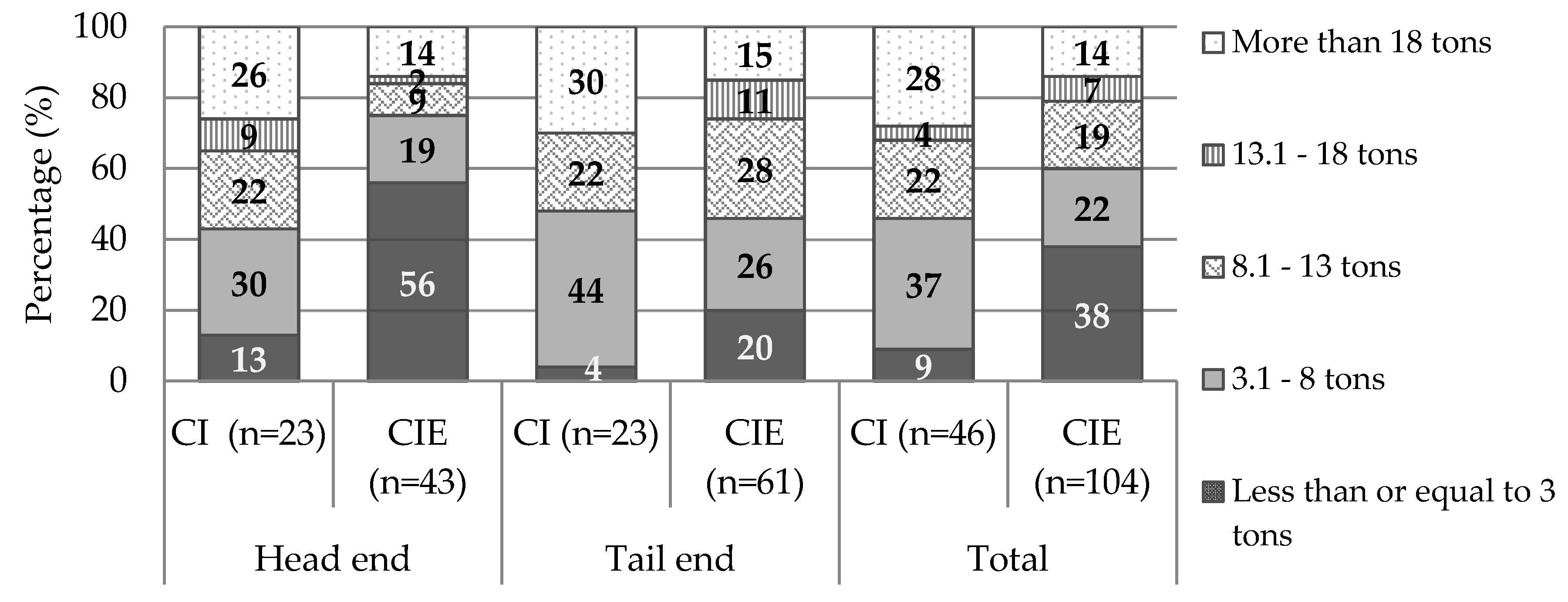



| Farmer | Gender | Educational Level | Household Members | Status in Family | Average Paddy Cultivation Land (ha) | |||||
|---|---|---|---|---|---|---|---|---|---|---|
| Male | Female | Low | Medium | High | ≤4 | >4 | Household Head | Resident | ||
| Head-end | ||||||||||
| CI (n = 23) (%) | 23 (100) | 0 (0) | 19 (83) | 4 (17) | 0 (0) | 6 (26) | 17 (74) | 21 (91) | 2 (9) | 2.08 |
| CIE (n = 43) (%) | 38 (88) | 5 (12) | 30 (70) | 3 (7) | 10 (23) | 17 (40) | 26 (60) | 27 (63) | 16 (37) | 1.92 |
| Tail-end | ||||||||||
| CI (n = 23) (%) | 23 (100) | 0 (0) | 17 (74) | 0 (0) | 6 (26) | 3 (13) | 20 (87) | 21 (91) | 2 (9) | 3.04 |
| CIE (n = 61) (%) | 54 (89) | 7 (11) | 41 (67) | 7 (12) | 13 (21) | 21 (34) | 40 (66) | 37 (61) | 24 (39) | 2.40 |
| Number of Respondents | Pearson Correlations of Linear Regression | ANOVA | ||||
|---|---|---|---|---|---|---|
| Paddy Yield in Dry-Season | Annual Paddy Yields | Mean Square | F | Sig. | ||
| Active participation in the irrigation operation and maintenance | 150 | 0.37 | 40.29 | 22.71 | 0.000 | |
| 150 | 0.33 | 15.38 | 14.92 | 0.000 | ||
| Farmer information sharing of water allocation | 150 | 0.23 | 16.05 | 8.28 | 0.005 | |
| 150 | 0.27 | 12.44 | 11.83 | 0.001 | ||
© 2017 by the authors. Licensee MDPI, Basel, Switzerland. This article is an open access article distributed under the terms and conditions of the Creative Commons Attribution (CC BY) license (http://creativecommons.org/licenses/by/4.0/).
Share and Cite
Kosanlawit, S.; Soni, P.; Shivakoti, G.P. The Relationship between Effective and Equitable Water Allocation, Local Rice Farmer Participation and Economic Well-Being: Insights from Thailand’s Chiang Mai Province. Water 2017, 9, 319. https://doi.org/10.3390/w9050319
Kosanlawit S, Soni P, Shivakoti GP. The Relationship between Effective and Equitable Water Allocation, Local Rice Farmer Participation and Economic Well-Being: Insights from Thailand’s Chiang Mai Province. Water. 2017; 9(5):319. https://doi.org/10.3390/w9050319
Chicago/Turabian StyleKosanlawit, Saowalak, Peeyush Soni, and Ganesh P. Shivakoti. 2017. "The Relationship between Effective and Equitable Water Allocation, Local Rice Farmer Participation and Economic Well-Being: Insights from Thailand’s Chiang Mai Province" Water 9, no. 5: 319. https://doi.org/10.3390/w9050319






